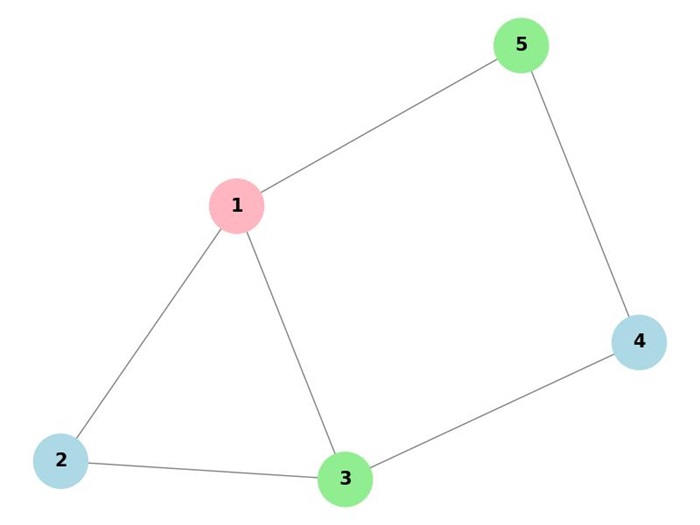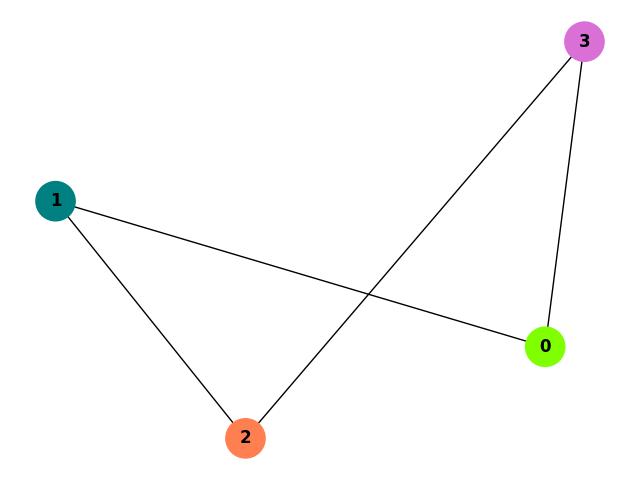
- Graph Theory - Home
- Graph Theory - Introduction
- Graph Theory - History
- Graph Theory - Fundamentals
- Graph Theory - Applications
- Types of Graphs
- Graph Theory - Types of Graphs
- Graph Theory - Simple Graphs
- Graph Theory - Multi-graphs
- Graph Theory - Directed Graphs
- Graph Theory - Weighted Graphs
- Graph Theory - Bipartite Graphs
- Graph Theory - Complete Graphs
- Graph Theory - Subgraphs
- Graph Theory - Trees
- Graph Theory - Forests
- Graph Theory - Planar Graphs
- Graph Theory - Hypergraphs
- Graph Theory - Infinite Graphs
- Graph Theory - Random Graphs
- Graph Representation
- Graph Theory - Graph Representation
- Graph Theory - Adjacency Matrix
- Graph Theory - Adjacency List
- Graph Theory - Incidence Matrix
- Graph Theory - Edge List
- Graph Theory - Compact Representation
- Graph Theory - Incidence Structure
- Graph Theory - Matrix-Tree Theorem
- Graph Properties
- Graph Theory - Basic Properties
- Graph Theory - Coverings
- Graph Theory - Matchings
- Graph Theory - Independent Sets
- Graph Theory - Traversability
- Graph Theory Connectivity
- Graph Theory - Connectivity
- Graph Theory - Vertex Connectivity
- Graph Theory - Edge Connectivity
- Graph Theory - k-Connected Graphs
- Graph Theory - 2-Vertex-Connected Graphs
- Graph Theory - 2-Edge-Connected Graphs
- Graph Theory - Strongly Connected Graphs
- Graph Theory - Weakly Connected Graphs
- Graph Theory - Connectivity in Planar Graphs
- Graph Theory - Connectivity in Dynamic Graphs
- Special Graphs
- Graph Theory - Regular Graphs
- Graph Theory - Complete Bipartite Graphs
- Graph Theory - Chordal Graphs
- Graph Theory - Line Graphs
- Graph Theory - Complement Graphs
- Graph Theory - Graph Products
- Graph Theory - Petersen Graph
- Graph Theory - Cayley Graphs
- Graph Theory - De Bruijn Graphs
- Graph Algorithms
- Graph Theory - Graph Algorithms
- Graph Theory - Breadth-First Search
- Graph Theory - Depth-First Search (DFS)
- Graph Theory - Dijkstra's Algorithm
- Graph Theory - Bellman-Ford Algorithm
- Graph Theory - Floyd-Warshall Algorithm
- Graph Theory - Johnson's Algorithm
- Graph Theory - A* Search Algorithm
- Graph Theory - Kruskal's Algorithm
- Graph Theory - Prim's Algorithm
- Graph Theory - Borůvka's Algorithm
- Graph Theory - Ford-Fulkerson Algorithm
- Graph Theory - Edmonds-Karp Algorithm
- Graph Theory - Push-Relabel Algorithm
- Graph Theory - Dinic's Algorithm
- Graph Theory - Hopcroft-Karp Algorithm
- Graph Theory - Tarjan's Algorithm
- Graph Theory - Kosaraju's Algorithm
- Graph Theory - Karger's Algorithm
- Graph Coloring
- Graph Theory - Coloring
- Graph Theory - Edge Coloring
- Graph Theory - Total Coloring
- Graph Theory - Greedy Coloring
- Graph Theory - Four Color Theorem
- Graph Theory - Coloring Bipartite Graphs
- Graph Theory - List Coloring
- Advanced Topics of Graph Theory
- Graph Theory - Chromatic Number
- Graph Theory - Chromatic Polynomial
- Graph Theory - Graph Labeling
- Graph Theory - Planarity & Kuratowski's Theorem
- Graph Theory - Planarity Testing Algorithms
- Graph Theory - Graph Embedding
- Graph Theory - Graph Minors
- Graph Theory - Isomorphism
- Spectral Graph Theory
- Graph Theory - Graph Laplacians
- Graph Theory - Cheeger's Inequality
- Graph Theory - Graph Clustering
- Graph Theory - Graph Partitioning
- Graph Theory - Tree Decomposition
- Graph Theory - Treewidth
- Graph Theory - Branchwidth
- Graph Theory - Graph Drawings
- Graph Theory - Force-Directed Methods
- Graph Theory - Layered Graph Drawing
- Graph Theory - Orthogonal Graph Drawing
- Graph Theory - Examples
- Computational Complexity of Graph
- Graph Theory - Time Complexity
- Graph Theory - Space Complexity
- Graph Theory - NP-Complete Problems
- Graph Theory - Approximation Algorithms
- Graph Theory - Parallel & Distributed Algorithms
- Graph Theory - Algorithm Optimization
- Graphs in Computer Science
- Graph Theory - Data Structures for Graphs
- Graph Theory - Graph Implementations
- Graph Theory - Graph Databases
- Graph Theory - Query Languages
- Graph Algorithms in Machine Learning
- Graph Neural Networks
- Graph Theory - Link Prediction
- Graph-Based Clustering
- Graph Theory - PageRank Algorithm
- Graph Theory - HITS Algorithm
- Graph Theory - Social Network Analysis
- Graph Theory - Centrality Measures
- Graph Theory - Community Detection
- Graph Theory - Influence Maximization
- Graph Theory - Graph Compression
- Graph Theory Real-World Applications
- Graph Theory - Network Routing
- Graph Theory - Traffic Flow
- Graph Theory - Web Crawling Data Structures
- Graph Theory - Computer Vision
- Graph Theory - Recommendation Systems
- Graph Theory - Biological Networks
- Graph Theory - Social Networks
- Graph Theory - Smart Grids
- Graph Theory - Telecommunications
- Graph Theory - Knowledge Graphs
- Graph Theory - Game Theory
- Graph Theory - Urban Planning
- Graph Theory Useful Resources
- Graph Theory - Quick Guide
- Graph Theory - Useful Resources
- Graph Theory - Discussion
Graph Theory - List Coloring
List Coloring in Graph Theory
List coloring is a variation of the graph coloring problem where each vertex in a graph has its own list of permissible colors.
In list coloring, permissible colors refer to the specific set of colors that are allowed to be assigned to a vertex in a graph.
Unlike standard graph coloring, where any color from a fixed set can be used, in list coloring, each vertex has its own list of permissible colors, which can vary from vertex to vertex.
The goal is to assign a color to each vertex from its respective list, ensuring that adjacent vertices have different colors.
- The assigned color for each vertex comes from its list of permissible colors.
- No two adjacent vertices share the same color.

Here,
Lists of permissible colors for each vertex:
Vertex 1: ['lightpink', 'lightblue']
Vertex 2: ['lightblue', 'lightgreen']
Vertex 3: ['lightpink', 'lightgreen']
Vertex 4: ['lightblue', 'yellow']
Vertex 5: ['lightgreen', 'yellow']
Color assignment: {1: 'lightpink', 2: 'lightblue', 3: 'lightgreen', 4: 'lightblue', 5: 'lightgreen'}
A graph is said to be list colorable if such an assignment exists for any collection of lists of allowable colors, as long as the size of each list is at least a certain value, called the list chromatic number of the graph.
List Chromatic Number
The list chromatic number of a graph is the smallest number k such that for any assignment of lists of size k to the vertices, the graph can be properly colored using the lists. It is denoted as X1(G), where G is the graph.
In simple terms, the list chromatic number defines the minimum size of the color list required for each vertex so that a valid coloring exists, where no two adjacent vertices share the same color, regardless of the specific colors in the lists.
For many graphs, the list chromatic number is equal to the chromatic number, but this is not always the case. Determining the list chromatic number can be more complex than finding the chromatic number.

Here,
Permissible color lists for each vertex: Node 0: ['Chartreuse', 'teal', 'coral'] Node 1: ['Chartreuse', 'teal', 'coral'] Node 2: ['teal', 'coral', 'Orchid'] Node 3: ['Chartreuse', 'coral', 'Orchid'] The graph is list colorable with the given lists. Coloring: Node 0: Chartreuse Node 1: teal Node 2: coral Node 3: Orchid The List Chromatic Number of the graph is: 3
The list chromatic number of the above graph is 3.
Properties of List Coloring
List coloring has various interesting properties that differentiate it from traditional graph coloring −
- Generalization: Every graph that is k-colorable is also list colorable with lists of size k, but the reverse is not necessarily true.
- Dependence on Lists: The feasibility of a proper list coloring depends on the specific lists of allowable colors assigned to the vertices.
- Flexibility: List coloring is more flexible in assigning colors when constraints exist on individual vertices.
Applications of List Coloring
List coloring has various applications in real-world scenarios, particularly in areas where constraints must be considered −
- Scheduling: In scheduling problems, tasks may have restrictions on which time slots or resources they can use. These restrictions can be modeled as lists of permissible options for each task, which must be assigned without conflicts.
- Frequency Assignment: In wireless networks, frequencies must be assigned to transmitters in such a way that interference is minimized. Each transmitter may have a restricted list of frequencies it can use, which can be represented through list coloring to avoid conflicts.
- Resource Allocation: In resource allocation problems, where resources are limited or certain resources are restricted for specific entities, list coloring ensures that each entity is assigned the most suitable and non-conflicting resources from its allowable list.
- Graph Labeling: In labeling problems, vertices may have constraints on the labels they can receive. List coloring provides a way to assign valid labels to vertices, ensuring that the constraints are met.
Algorithm for List Coloring
Finding a valid list coloring for a graph can be a challenging task. However, several algorithms and techniques have been developed to handle specific cases −
- Backtracking: A backtracking approach can be used to try different color assignments for each vertex from its permissible list. It checks for conflicts at each step and backtracks when necessary to find a valid coloring.
- Greedy Algorithm: A greedy algorithm can sometimes produce a solution if the color lists are large enough. However, it does not guarantee a solution for all types of graphs.
- Special Graph Classes: For certain graph classes, such as bipartite or planar graphs, there are more efficient algorithms that can be used for list coloring.
Despite these techniques, list coloring remains an NP-hard problem in the general case.
To better understand list coloring, consider the following examples −
Simple Graph with Lists
Suppose we have a graph with three vertices (A, B, C) and edges (A-B, B-C). Each vertex has the following list of permissible colors:
- A: {Red, Blue}
- B: {Green, Red}
- C: {Blue, Green}
A valid list coloring would be:
- A: Red
- B: Green
- C: Blue
Each vertex is assigned a color from its list, and no two adjacent vertices share the same color.
Constraints on Coloring
Consider a triangle graph (A-B-C-A) with the following lists:
- A: {Red, Green}
- B: {Green, Blue}
- C: {Red, Blue}
A valid coloring is not possible in this case, as no assignment satisfies both the adjacency condition and the constraints imposed by the lists.
Challenges in List Coloring
List coloring poses unique challenges compared to traditional graph coloring:
- Increased Complexity: The presence of individual lists for each vertex increases the complexity of finding a proper coloring.
- No Universal Algorithm: There is no single algorithm that guarantees a solution for all graphs and list assignments.
- Dependence on List Sizes: The feasibility of a list coloring depends on the size and content of the lists, which may vary between vertices.
Despite these challenges, list coloring remains an important and useful tool for solving graph coloring problems with specific constraints.